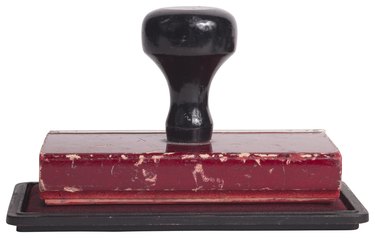Things You'll Need
Laundry detergent
Scrap corrugated cardboard
Painter's tape
Rubber or foam stamps
Fabric-ink stamp pads or fabric paints
Foam brush
Iron
Ironing board
Brown craft paper or old cotton pillowcase

Stamping designs on fabric allows you the opportunity to personalize pillows, clothing, bags or even tea towels to show off around the house or to give to friends and loved ones as gifts. Smooth, flat textiles with little to no texture work best for stamping; otherwise, the image may not come out as intended. Test your stamping technique on scrap paper or on a fabric similar to the project material to get a feel for how the stamped images will turn out.
Step 1
Wash and dry all the fabric project pieces before stamping, if possible, to ensure they are free from chemicals or treatments from manufacturing. Follow the care tag's instructions, if the item has one; otherwise, wash it on the gentle cycle and dry with low heat. If the item is non-washable, as is the case with some throw pillows, skip this step.
Video of the Day
Step 2
Place a sheet of scrap cardboard on the work surface to prevent ink or paint from bleeding through. Set the project material atop the cardboard and smooth it out. If working with clothing, such as a T-shirt or a leg on yoga pants, place another sheet of scrap corrugated cardboard on the inside of the item behind the area you wish to stamp. This keeps the design from bleeding through to the other part of the fabric. If you're working with a stretchy material that is hard to keep smooth, wrap it taut around a piece of cardboard and tape it on the back side with painter's tape.
Step 3
Apply ink or paint to a stamp in a thin layer. If you're using an ink pad, dab the stamp onto the pad several times, then press it firmly onto the desired location on the fabric. If you're working with paints, apply a little fabric paint to the stamp surface using a foam brush as an applicator. Keep the paint layer thin, but thick enough to cover the entire design on the stamp. Press the stamp onto the fabric. Lift the stamp straight up to avoid smearing the wet ink or paint.
Step 4
Allow the designs to dry completely; this may take at least an hour.
Step 5
Plug in the iron and set it to low or medium heat. Choose the no-steam option if it's a steam iron. Place the decorated fabric on the ironing board, smoothing it as much as possible.
Step 6
Place a sheet of brown craft paper or an old cotton pillowcase over the project fabric, then iron the paper or pillowcase for a few seconds to set the ink on your project. Ironing over paper or a pillowcase ensures the iron will not discolor your project fabric, if delicate, and also prevents an errant blob of paint from getting on the iron. Unplug the iron when you finish.
Tip
Make your own stamps from craft foam cut into shapes or from sheets of shipping foam. Even a halved potato carved to the desired shape can be used as an inexpensive homemade stamp.
Create a multi-colored stamped design by brushing one color of paint on one portion of the stamp, with other colors on other areas of the stamp. Since you reapply the paint between stampings, no two applications will turn out exactly the same.
Stamp one color of paint or ink over another, but shifted slightly to one side and up or down, once the first color is almost dry. This creates the impression of dimension or a shadow.
If the decorated object is washable, wash it only as needed with a detergent for delicate fabrics, or hand-wash it. Some stamping inks fade when washed, although those designed for fabrics should not.
Warning
Do not iron the project if the ink or paint is still wet, or the iron may smear the design.
Video of the Day